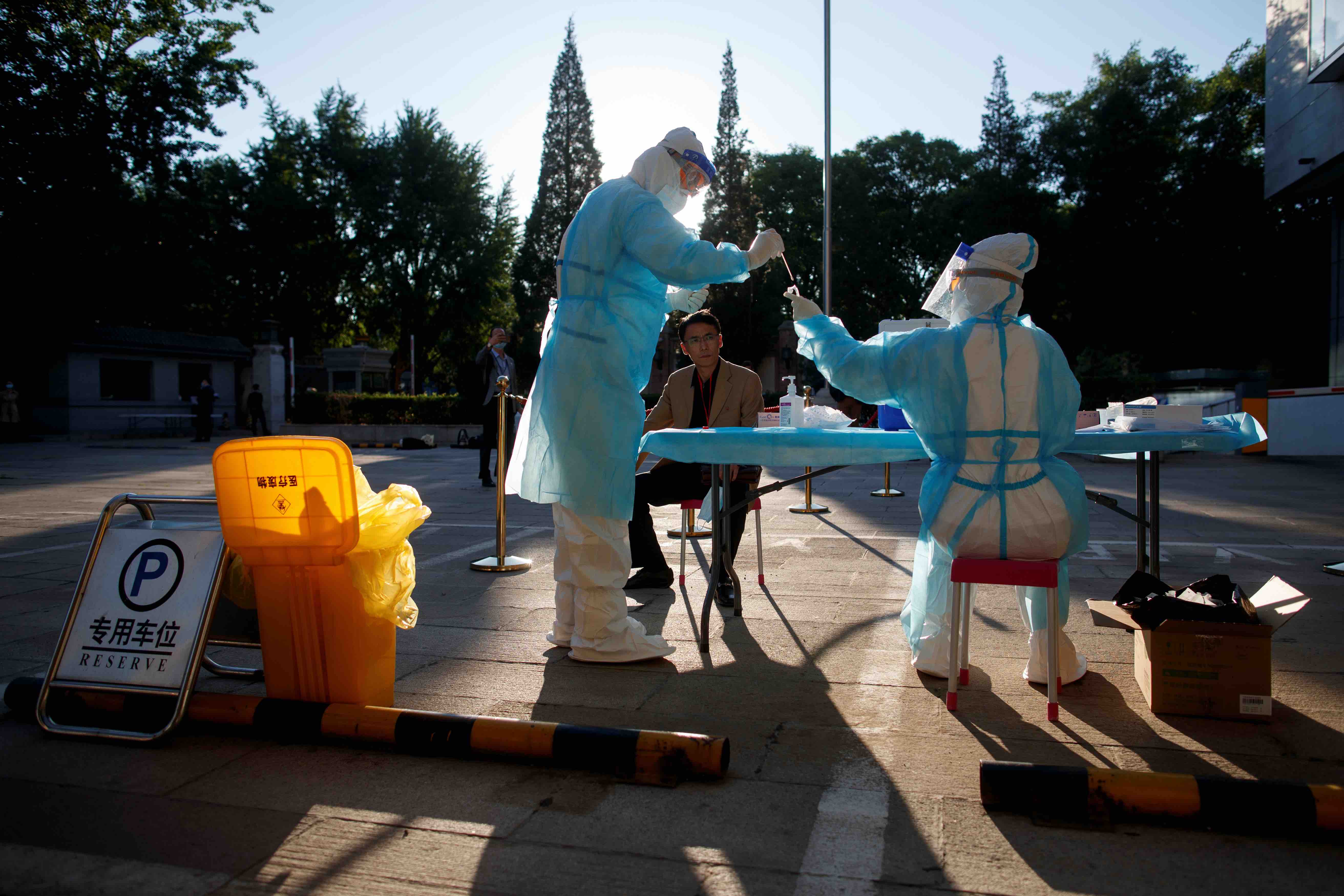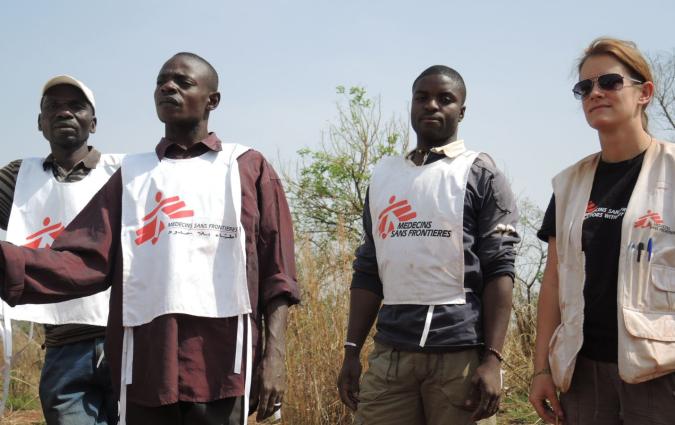It's time for newsrooms to tackle taboos about mental health. Here's how

Medical staff conduct a test on a journalist before he is admitted to the Chinese People's Political Consultative Conference (CPPCC). REUTERS/Thomas Peter/Pool
This is an abridged transcript of the seminar Hannah offered as part of our Summer School. It reflects her personal views, and not the views of the Ethical Journalism Network. You can watch the seminar in here.
I would like to share my thoughts about mental health and about the way that journalists can be affected by the work they do. As part of this conversation, I’ll share some of my own experiences. I’ll also reflect on how a decade of working in media safety taught me the language of mental health. I’ll talk about some of the taboos in our industry that prevent more open conversations about emotional health and wellbeing and I’ll offer some of my thoughts about what we might do better as an industry and as individuals to create safe spaces for people to feel able to speak about their experiences.
Before sharing my thoughts on mental health and the media, I’d like to acknowledge how privileged I am to be able to speak relatively openly about my experiences of mental ill health.
At the end of last year, I accepted a diagnosis of post-traumatic stress disorder, or PTSD. This summer, I shared my story for the first time in an essay for the Poynter Institute. Although the traumas I faced were awful, and there have been times when my life has been tough, I am on the road to recovery – even if that road isn’t always linear.
It can still be quite draining to talk about my experiences, but I do so because it is important to me that I use my position and relative privilege to help others who suffer understand they are not alone. I want my story to be a hopeful one and a helpful one.
As I said, I know I have a degree of privilege many do not. Recent months have underscored the unique burden borne by Black journalists and journalists of colour, with the disproportionate impact on Black communities of COVID-19 and the protests sparked by the murder of George Floyd.
It took me a lot to get to the stage where I felt able to speak about my experiences. Some people will never feel able to do so. Ours is an industry that has made strides in encouraging more open conversations about mental health in the past few years. But it is nowhere near where it should be in 2020.
There are still immense stigmas that exist. People who are marginalised by our systemically white, heterosexual cis-male, university-educated industry are still more likely to suffer in silence, and yet they are more likely to be impacted by these pressures.
Mental ill health often comes with a large dose of shame, but in my experience there’s also a real fear that an admission you are suffering will compromise your career. Time and again colleagues have told me they keep quiet for fear of missing out on a particular assignment. Ours is a macho industry, one where being tough is the default.
How COVID-19 created the perfect storm
I want to give a little bit of context about the current climate that I think might be helpful. Even before the global pandemic, our industry faced a crisis of trust, the pressures of being hyper-connected, relentless breaking news, a volume of voices and noise that we needed to sift through in order to figure out what was fact and what was fiction.
Before the pandemic, I knew of many friends and colleagues who were suffering significant stress caused by this perfect storm of factors. Some call what they were going through ‘burn out’, but to me that implies a degree of blame, rather than recognising that this is something which often stems from the conditions of our professional work.
COVID-19 exacerbated an already precarious situation. People found themselves furloughed, jobs gone for programmes that couldn’t be made and stories that couldn’t be told. A slump in ad revenues added further pressure to a battered business model. We ran to redefine an industry in days that had been built over decades.
At the same time, we were figuring out what this meant for our home lives too, and facing a situation that was unprecedented and uncertain. All this, while we were covering arguably the biggest global story of our lifetimes, often from a distance, often without knowing who or what to believe. I think it would be enough to make anyone a little jittery and certainly anxiety is commonplace in our industry and the wider public, and I think this is a critical moment in the media in terms of mental health and wellbeing.
How to learn the language of mental health
From 2010 until last year, I worked for the International News Safety Institute (INSI), a charity bringing together some of the world’s leading news organisations to share information about safety aimed at supporting colleagues working in difficult and dangerous places. During my time there, I learned the language of mental health and saw how newsrooms seemed more adept at conversations around physical than emotional safety. They were well versed at providing journalists with physical flak jackets but there was often a glaring absence of what I call ‘emotional flak jackets’ – the preparation and practical tools needed to help journalists understand how their work might affect their psychological safety.
For many years, discussions around mental health were mainly limited to post-traumatic stress disorder (PTSD), a mental illness which can develop when people are exposed to, or witness, life-threatening events. This is a serious condition, but one that is treatable and still relatively rare in terms of the numbers it affects. And if these conversations were limited to PTSD, they were further focussed on foreign correspondents and the assumption that PTSD really only happened to those who went to war.
It’s certainly the case that those who cover conflict can and do develop PTSD. Many of us may know the type: those return repeatedly to war zones, whose personal relationships suffer, who find a way of coping through drinking too much or extra-marital affairs, or other kinds of self-sabotaging behaviour – all of this a foil to their ability to accept they’re not coping, but too often seen as a badge of honour in newsrooms.
We didn’t really talk about the devastating impact PTSD can have on those it affects and by extension those close to the person who has it, on the newsrooms and on our wider industry. We didn’t really talk about PTSD when it manifested itself in other ways: for the local journalists who worked in places like México who were exposed to trauma day in and day out and who could never escape, or those who reported on murders or road traffic collisions, journalists who were effectively one of a set of early responders to a scene of tragedy. We didn’t really talk about PTSD as a result of gendered violence journalists were exposed to either.
I often wondered why but perhaps it has something to do with the people who were the gatekeepers of these conversations and the fact they were often men, and in instances where they were safety advisers, they were ex-military men.
We didn’t seem to be considering the spectrum of mental health concerns that impact journalists, one in which PTSD lies at the far end and other issues along the rest of the continuum, no less valid and sometimes more prevalent – such as anxiety, stress, depression, or vicarious trauma which can come about as a result of being exposed to graphic images – or moral injury.
Hannah’s story
Before I talk a bit more about moral injury, I want to share something of my personal story to give some background as to why and how it was that I became so interested in these conversations.
Back in 2010, I covered the earthquake in Haiti for UK’s Channel 4 News. When I travelled to Haiti for them, it was my third visit to the country. I had been there twice in 2004 as a freelance journalist. Some of what I witnessed was disturbing and dangerous. What I did not recognise at the time was that those experiences were exacerbated by earlier traumas connected either directly or indirectly with my first two visits to Haiti. Of course, my experience cannot compare with the levels of trauma that hundreds of thousands of Haitians went through, but they had a significant impact on my mental health.
A couple of months after returning from Haiti in January 2010, I left the newsroom and joined INSI.
In the ensuing nine years, I helped write and research several reports referencing mental health in the media, not yet openly recognising my motivation stemmed mainly from my own experiences. But my work also exposed me to situations that exacerbated my mental ill health.
By early 2018, I was experiencing some pretty significant symptoms of PTSD – flashbacks, nightmares, poor sleep, mood swings, an inability to concentrate. I held down my job, put on a brave face but a lot of the time I felt like I was reeling inside and sometimes I felt a fraud to be the director of a journalism safety organisation.
Late last year, I accepted my diagnosis of PTSD resulting from various traumas in my professional and personal life, including sexual assault as a journalist on the eve of my first visit to Haiti, and an abusive relationship with someone I met through my journalism work. I resisted seeking out a diagnosis until I had started making a recovery. I did so in part because I was worried it would impact my career, but also because over many years, my abuser undermined my mental health and I was fearful of the consequences of admitting a diagnosis. Now I know his abuse was one of the causes of my PTSD and none of this was my fault.
Hannah’s work
Long before I found the words to share my own story, I wrote reports and articles specifically related to mental health and physical safety.
After Lara Logan was sexually assaulted in Egypt in 2012, I co-wrote No Woman’s Land – On the Frontlines with Female Reporters, the first book dedicated to the safety of women journalists. Back then, I remember conversations about whether or not women journalists should go to the frontline, as if women themselves were the liability), underscoring the point I made before about why it is so much harder for some people to share their traumatic experiences. Back then, I wasn’t even close to talking about my own sexual assaults as a journalist, but it motivated my work and this book.
Later still, I co-authored a report with Professor Anthony Feinstein for the Reuters Institute for the Study of Journalism. Our study looked into the emotional impact on journalists of covering the refugee crisis and it was one of the first real discussions about moral injury and the media.
Unlike PTSD or anxiety disorders or depression, moral injury is not a mental illness. But it can cause significant emotional distress if left unaddressed and untreated. The best way I’ve found to think about it is this: we all have a moral compass. For example, we recognise certain things as being right and wrong. Sometimes, as journalists we find ourselves in situations where we are forced to compromise what we believe or we see other people doing that. We are torn between what has been referred to as our obligation to help and our duty to report.
Moral injury is an injury done to a person’s conscience or moral compass when they perpetrate, witness or fail to prevent acts that go against their own ethical values or codes of conduct. Moral injury is associated with feelings of guilt and shame, emotions that come about when journalists are asked to do something which perhaps requires them to step outside of their roles as journalists.
Through my conversations with Professor Feinstein, and through the work we have done in this area, we believe moral injury could be a real risk to people in the news industry because of some of the pressures brought about by the global pandemic. It’s something that would merit further discussion and research, which we intend to do.
How to improve your mental wellbeing
I’m buoyed by conversations with some news organisations who are really recognising the value and importance of helping their colleagues during these uncertain times. It’s important to realise there are steps individuals can take towards their own mental wellbeing. We live in very uncertain times. So one thing I’ve been trying to do is to focus on what I can control over what I can’t control.
That can be difficult, and I have found that hard in recent days, with a house move, new schools for my kids, work pressures, changes to government guidelines in the UK, and a host of other things. But I try to remind myself that I can’t control other people’s behaviour, or government policy, and that getting anxious about it expends excess energy.
I rely on exercise as something to manage my mental health, so I’m a strong advocate of that. I realise that it’s not always easy or possible for people, but for me running has been a huge help and I do believe running, marathon running in particular, has many parallels in terms of learning how to pace oneself and the importance of recovery too when you’re faced with a long road ahead of you.
In this world where the borders between work and home life are blurry, I think it’s helpful to stick to certain routines to help me set parameters between personal and professional lives.
It’s really important to try to get a change of scene from the screen, be that switching off for some time alone, or to spend some time with friends and family if that is possible. One of the biggest pressures we are facing as an industry is the exhaustion of being hyper-connected in a still disconnected world.
Practically, I’ve tried to limit the number of Zoom calls I do in a day, and space them out. I also try to have phone calls with people occasionally instead of face to face ones. I have come to really appreciate the need and desire to disconnect too.
I know that this might seem anathema to being a journalist, but I know this constant urge to be connected is really affecting the mental health of people in our industry when the reality is that we don’t all need to be connected all the time, just as in the past we weren’t always on call.
We have to get better at recognising the risk of being connected all the time. It’s really important that managers model that behaviour as well. And that may well not come naturally. We probably all know the anecdotes of the editors who scarcely sleep so they can listen to the radio all night long and be seconds ahead of the competition on breaking stories. But what message does that send to their colleagues?
It’s also really important we recognise the burden carried by certain journalists and how newsrooms manage that too so the overriding pressure doesn’t sit with one group of people. So, just as perhaps is the case in big breaking news stories, in hostile environment situations, it’s worth thinking about rotating teams on and off stories, giving them time to decompress between deployments, and thinking about how you manage situations in terms of who is back in the newsroom and who isn’t, as well as the dynamics of relationships when some people want to be in the office and can’t be and vice-versa.
And, as with any long-term story, it’s also important to acknowledge that there are other news events too that will need resourcing and may well impact severely on the mental health of journalists – take the recent explosion in Beirut as one example or the situation in Belarus.
Why we need more empathy in our newsrooms
In some of the most effective environments where I have seen spaces opening up for people to start sharing their experiences of mental health, it’s where there has been real role-modelling from managers. It’s so important that newsroom leaders communicate clearly and frequently about policies, about expectations, about encouraging people to share their experiences, and sometimes that may mean them sharing some of their own stories.
I think one of the positives that has come from COVID-19 is that newsrooms have become more democratic. In the past, editorial meetings would have been dominated by a minority of voices from the upper echelons of newsrooms. Now, there’s perhaps more opportunity for democracy in an online meeting. We have been forced to be more collaborative and creative in ways we might not previously have considered. I think these are encouraging signs for mental health conversations.
Something else has come from this that may help lessen the taboo in our industry. It’s incorrect to say that COVID-19 is the great leveller because some people have been affected more than others either by the disease or by the conditions in which they are living. However, we are all negotiating a world that is very different from the one we inhabited until earlier this year, and this means everyone faces some degree of challenge and perhaps therefore there is some more openness to share those challenges.
It’s been encouraging to see some newsrooms create spaces for staff to speak and share their experiences, to gain the benefits of sessions designed to help them manage stress and change, and offering particular help to managers to manage in this environment. Those organisations that are flexible to understanding the pressures on people caused by homeschooling, caring for relatives, or living in places where work spaces are compromised are also more likely to encourage more open conversations as they look out for their staff.
I’m really heartened by the change in tune even in the past few months around mental health in the media. I know there are taboos, but some of the conversations I’ve been having I think would have been impossible even a year ago. Journalists are by and large a resilient group of people, whose job is immensely important. I think that a sense of validation, and understanding how important our work is, goes a long way to securing a better sense of our need for mental wellbeing. I know there are still taboos, and I know that it is a scary thing for anyone to admit vulnerability. Believe me: I’ve been there.
But I’m a fervent believer in the fact that vulnerability can be a strength, that it brings empathy and understanding and it does so in a world that is crying out for both of those. And if coupled with the right kind of support so people can start to speak openly and be encouraged to feel safe doing so, I believe that can only be good for our industry and make for journalism with more humanity.







